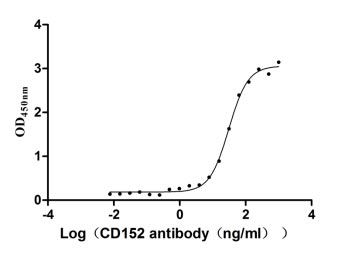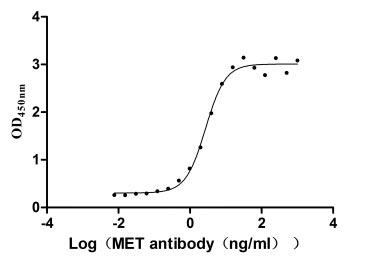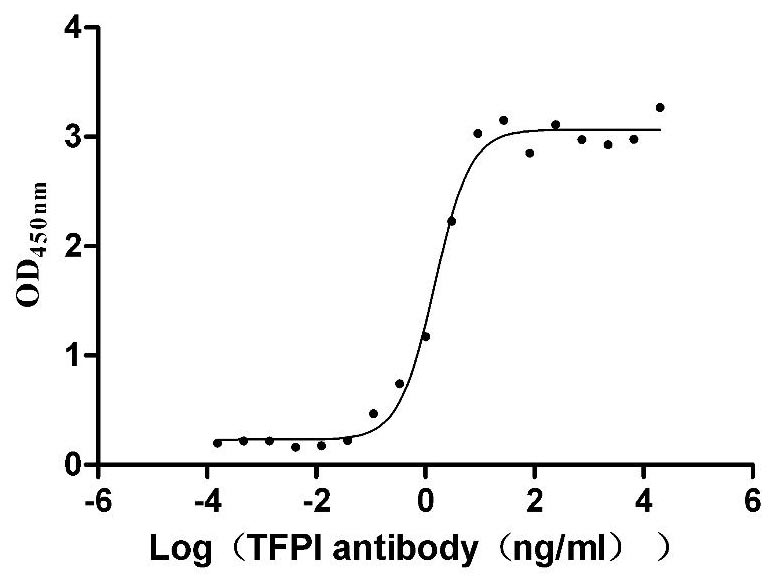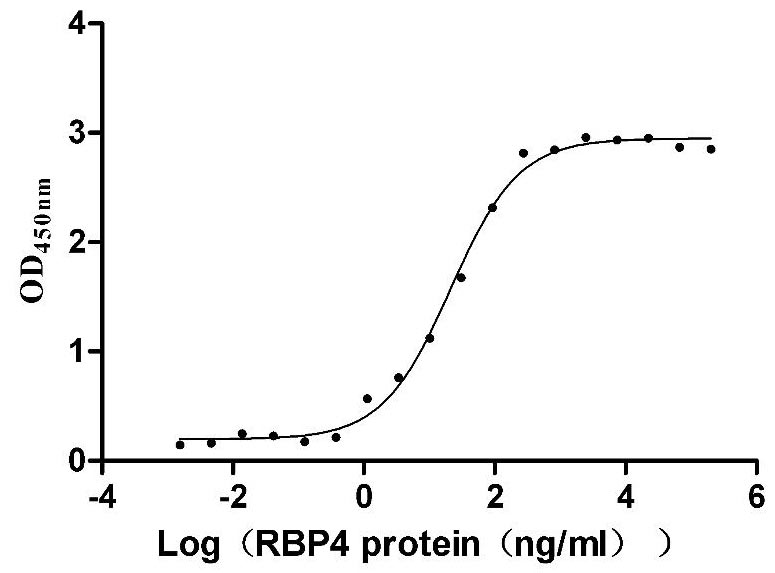Recombinant Human Lysophosphatidic acid receptor 1 (LPAR1)
-
货号:CSB-CF013047HU
-
规格:
-
来源:in vitro E.coli expression system
-
其他:
产品详情
-
基因名:
-
Uniprot No.:
-
别名:LPAR1; EDG2; LPA1; Lysophosphatidic acid receptor 1; LPA receptor 1; LPA-1; Lysophosphatidic acid receptor Edg-2
-
种属:Homo sapiens (Human)
-
蛋白长度:full length protein
-
表达区域:1-364
-
氨基酸序列MAAISTSIPVISQPQFTAMNEPQCFYNESIAFFYNRSGKHLATEWNTVSKLVMGLGITVC IFIMLANLLVMVAIYVNRRFHFPIYYLMANLAAADFFAGLAYFYLMFNTGPNTRRLTVST WLLRQGLIDTSLTASVANLLAIAIERHITVFRMQLHTRMSNRRVVVVIVVIWTMAIVMGA IPSVGWNCICDIENCSNMAPLYSDSYLVFWAIFNLVTFVVMVVLYAHIFGYVRQRTMRMS RHSSGPRRNRDTMMSLLKTVVIVLGAFIICWTPGLVLLLLDVCCPQCDVLAYEKFFLLLA EFNSAMNPIIYSYRDKEMSATFRQILCCQRSENPTGPTEGSDRSASSLNHTILAGVHSND HSVV
Note: The complete sequence including tag sequence, target protein sequence and linker sequence could be provided upon request. -
蛋白标签:N-terminal 10xHis-tagged
-
产品提供形式:Liquid or Lyophilized powder
Note: We will preferentially ship the format that we have in stock, however, if you have any special requirement for the format, please remark your requirement when placing the order, we will prepare according to your demand. -
缓冲液:Lyophilized from Tris/PBS-based buffer, 6% Trehalose, pH 8.0
-
储存条件:Store at -20°C/-80°C upon receipt, aliquoting is necessary for mutiple use. Avoid repeated freeze-thaw cycles.
-
保质期:The shelf life is related to many factors, storage state, buffer ingredients, storage temperature and the stability of the protein itself.
Generally, the shelf life of liquid form is 6 months at -20°C/-80°C. The shelf life of lyophilized form is 12 months at -20°C/-80°C. -
货期:Basically, we can dispatch the products out in 1-3 working days after receiving your orders. Delivery time may differ from different purchasing way or location, please kindly consult your local distributors for specific delivery time.Note: All of our proteins are default shipped with normal blue ice packs, if you request to ship with dry ice, please communicate with us in advance and extra fees will be charged.
-
注意事项:Repeated freezing and thawing is not recommended. Store working aliquots at 4°C for up to one week.
-
Datasheet & COA:Please contact us to get it.
相关产品
靶点详情
-
功能:Receptor for lysophosphatidic acid (LPA). Plays a role in the reorganization of the actin cytoskeleton, cell migration, differentiation and proliferation, and thereby contributes to the responses to tissue damage and infectious agents. Activates downstream signaling cascades via the G(i)/G(o), G(12)/G(13), and G(q) families of heteromeric G proteins. Signaling inhibits adenylyl cyclase activity and decreases cellular cAMP levels. Signaling triggers an increase of cytoplasmic Ca(2+) levels. Activates RALA; this leads to the activation of phospholipase C (PLC) and the formation of inositol 1,4,5-trisphosphate. Signaling mediates activation of down-stream MAP kinases. Contributes to the regulation of cell shape. Promotes Rho-dependent reorganization of the actin cytoskeleton in neuronal cells and neurite retraction. Promotes the activation of Rho and the formation of actin stress fibers. Promotes formation of lamellipodia at the leading edge of migrating cells via activation of RAC1. Through its function as lysophosphatidic acid receptor, plays a role in chemotaxis and cell migration, including responses to injury and wounding. Plays a role in triggering inflammation in response to bacterial lipopolysaccharide (LPS) via its interaction with CD14. Promotes cell proliferation in response to lysophosphatidic acid. Required for normal skeleton development. May play a role in osteoblast differentiation. Required for normal brain development. Required for normal proliferation, survival and maturation of newly formed neurons in the adult dentate gyrus. Plays a role in pain perception and in the initiation of neuropathic pain.
-
基因功能参考文献:
- ATX-LPA axis facilitates estrogen-induced endometrial cancer cell proliferation via MAPK/ERK signaling pathway. PMID: 29328374
- DLD-C-F cells formed large-sized colonies, but not DLD-F-C cells, correlating with LPAR1 and LPAR6 gene expression levels. These results suggest that LPA1 and LPA6 may regulate the colony formation activity in DLD1 cells treated with anticancer drugs. PMID: 29369010
- endogenous LPA1 receptor signaling and regulation PMID: 28943105
- The increased expression of LPA and LPAR1 is associated with the fibrosis and hypertrophy of the ligamentum flavum in patients with Lumbar Spinal Stenosis. PMID: 28323698
- myeloma cells stimulate mesenchymal stem cells (MSCs to produce autotaxin, an indispensable enzyme for the biosynthesis of lysophosphatidic acid, and LPA receptor 1 (LPA1) and 3 (LPA3) transduce opposite signals to MSCs to determine the fate of MSCs. PMID: 27641212
- LPA1 plays a critical role in EGF responses and that FFA4 agonists inhibit proliferation by suppressing positive cross-talk between LPA1 and the EGF receptor PMID: 27474750
- ADAMTS7 and LPA single nucleotide polymorphisms are related to a 24-h ambulatory systolic-diastolic pressure regression index. PMID: 28092973
- Polymorphism rs7023923 located near LPAR1 gene: the association of rs7023923 with monocytosis was confirmed among healthy blood donors (p = 0.0156) but not among patients admitted for elective coronarography (p = 0.61). PMID: 25563464
- These results suggest that autotaxin-LPA-LPA receptor 1-AKT1 signaling axis is critical for maintaining Cancer stem cells(CSC) characteristics through an autocrine loop and provide a novel therapeutic target for ovarian CSCs PMID: 26800320
- LPA-type agonist, via Carbonyl-oxygen/Lys39 interaction facilitates the formation of a hypothetical N-terminal cap tightly packed over the LPA1 heptahelical bundle. PMID: 26268898
- Data show high expression levels of LPAR2 and LPAR1 in endometrial cancer tissue with positive correlations with FIGO stage suggesting them as potential biomarkers for endometrial cancer progression. PMID: 26327335
- Data suggest LPA (lysophosphatidic acid; acting via LPAR1) and endothelin activate Cdc42, concurrent with biphasic decrease in Rac1 activity, differential effects on RhoA; LPA/endothelin stim. leads to remodeling of invadosomes in melanoma cells. PMID: 26740622
- we show that LPAR1 is a novel susceptibility gene for human essential hypertension and that stress, such as shortage of sleep, increases the susceptibility of patients with risk allele to essential hypertension. PMID: 26123684
- Study presents three crystal structures of LPA1 in complex with antagonist tool compounds selected and designed through structural and stability analyses. PMID: 26091040
- Results indicate that lysophosphatidic acid-lysophosphatidic acid receptor 1 (LPA-LPA1) signaling contributes to the activation of rheumatoid arthritis fibroblast-like synoviocytes (FLSs). PMID: 25273676
- Lysophosphatidylethanolamine utilizes LPA(1) and CD97 in a breast cancer cell line. PMID: 23838008
- LPA1 and LPA2 are major LPA receptor subtypes compared with low-expressed LPA3 in PANC-1 tumor cells. PMID: 24061591
- Lysophosphatidic acid (LPA) increased hepatocellular carcinoma cells cell invasion, which was LPA-receptor dependent. PMID: 23569130
- This review aims to characterize gintonin as an LPA receptor ligand and lists the advantages of LPA-ginseng protein complexes over free LPAs. PMID: 23017203
- study identified a novel role of TGFbeta in the control of LPA1 expression and LPA1-coupled biological functions, adding LPA1 to the list of TGFbeta-repressed target genes PMID: 22824789
- CD97 expression in human thyroid cancers correlated with LPA receptor and markers of aggressiveness including Ki67 and pAKT. PMID: 22797060
- a crosslink between Egr-1 and periostin in cancer cells PMID: 22659570
- The ability of LPA-LPA(1) signaling to promote epithelial cell apoptosis and fibroblast resistance to apoptosis may therefore contribute to the capacity of this signaling pathway to regulate the development of pulmonary fibrosis after lung injury. PMID: 22021336
- CD97 functioned to mediate invasion in prostate cancer cells, by associating with lysophosphatidic acid receptor 1 (LPAR1), leading to enhanced LPA-dependent RHO and extracellular signal-regulated kinase activation. PMID: 21978933
- the ATX-LPA-LPAR axis is a critical regulator of embryonic vascular development that is conserved in vertebrates PMID: 21971049
- This work shows for the first time that key components of the LPA pathway are modulated following traumatic brain injuries in humans. PMID: 21234797
- Mutation in LPA1 gene indicate that alteration in LPA receptor gene may play some role in the pathogenesis in human osteosarcoma cells. PMID: 21116120
- LPA1 receptor has a role in angiogenesis in tumor cells and xenografts PMID: 20708100
- Data show that CLL cells express LPA receptors LPA(1-5) and VEGF receptors, and the plasma levels of VEGF are elevated in CLL patients. PMID: 19860625
- show that human microglia express LPA receptor subtypes LPA(1), LPA(2), and LPA(3) on mRNA and protein level. LPA activation of C13NJ cells induced Rho and extracellular signal-regulated kinase activation and enhanced cellular ATP production. PMID: 19899077
- LP(A1) and myelin basic protein colocalized in brain, but oligodendrocyte soma showed stronger signals for LP(A1) than myelinated fibers, whereas the reverse was true for myelin basic protein so LP(A1) may be involved in myelin formation or maintenance. PMID: 11948806
- demonstrate that two biological fluids, blood plasma and seminal plasma, differentially activate LPA receptors PMID: 12123830
- Data suggest that LPA(1) receptors couple to a G(i)-phosphoinositide 3-kinase-Tiam1 pathway to activate Rac, with consequent suppression of RhoA activity, and thereby stimulate cell spreading and motility. PMID: 12393875
- lysophosphatidic acid-coupled LPA1/EDG-2 receptors are endocytosed via a dynamin2- and Rab5-dependent pathway PMID: 12668728
- LPA acts as a potent stimulator of colon cancer progression, although the binding to LPA1 and LPA2 induces slightly different responses. PMID: 12670925
- LPA stimulation promotes the interaction of the LPA(2) receptor with a focal adhesion molecule, TRIP6 PMID: 14688263
- EDG-2 expression was increased in low-grade adenoma compared with that in normal mucosa (P < 0.001). EDG-2 expression was significantly greater in adenomas with larger diameters (P < 0.001). PMID: 14696401
- Amyloid beta-protein stimulated in monocytes the gene expression for sphingosine-1-phosphate receptor 2, which is amyloid beta-protein-induced migration. PMID: 15208267
- data suggest that endothelial differentiation gene EDG-7 and EDG-2 lysophosphatidic acid receptors play a diverse role in mesangial cell proliferation PMID: 15292052
- formation of the LPA receptor/PDZ domain-containing RhoGEF complex plays a pivotal role in LPA-induced RhoA activation PMID: 15755723
- We show that in addition to promoting LPA(1) signaling, membrane cholesterol is essential for the association of LPA(1) with beta-arrestin, which leads to signal attenuation and clathrin-dependent endocytosis of LPA(1). PMID: 16263766
- These findings demonstrate that trafficking of LPA1 to the nucleus is influenced by cell-matrix interactions and that nuclear LPA1 may be involved in regulating intranuclear protein phosphorylation and signalling. PMID: 16716145
- LPA(1) transduces Galphai-dependent signals to promote nuclear localization of androgen receptor and cell proliferation PMID: 16809448
- EDG2 and EDG4 cooperate to promote LPA-stimulated chemotaxis in breast tumor cell lines. PMID: 17496233
- expression of LPA-induced inflammatory response genes is mediated by LPA1 and LPA3 PMID: 17923111
- Lysophosphatidic acid receptor 1 may contribute to the pathogenesis of rheumatoid arthritis through the modulation of fibroblast-like synoviocyte migration and cytokine production. PMID: 18006645
- distinct molecular mechanisms regulate agonist-dependent and PMA-dependent internalization of the LPA 1 receptor. PMID: 18089565
- Down-regulation of EDG2 is functionally important to suppression of tumor metastasis in breast neoplasms. PMID: 18089805
- Through the stepwise association study, an SNP located in the promoter region of EDG2 (-2,820G/A; rs10980705) showed significant association with knee osteoarthritis in two independent populations. PMID: 18325907
- LPA may play a role in angiogenesis of endometrium and placenta through induction of IL-8 in endometrial stromal cells during pregnancy. PMID: 18617617
显示更多
收起更多
-
亚细胞定位:Cell surface. Cell membrane; Multi-pass membrane protein. Endosome.
-
蛋白家族:G-protein coupled receptor 1 family
-
组织特异性:Expressed in many adult organs, including brain, heart, colon, small intestine, placenta, prostate, ovary, pancreas, testes, spleen, skeletal muscle, and kidney. Little or no expression in liver, lung, thymus, or peripheral blood leukocytes. Detected in l
-
数据库链接:
HGNC: 3166
OMIM: 602282
KEGG: hsa:1902
STRING: 9606.ENSP00000351755
UniGene: Hs.126667
Most popular with customers
-
Recombinant Human Cytotoxic T-lymphocyte protein 4 (CTLA4), partial (Active)
Express system: Mammalian cell
Species: Homo sapiens (Human)
-
Recombinant Human Hepatocyte growth factor receptor (MET), partial (Active)
Express system: Mammalian cell
Species: Homo sapiens (Human)
-
Recombinant Human Tissue factor pathway inhibitor (TFPI), partial (Active)
Express system: Mammalian cell
Species: Homo sapiens (Human)
-
Recombinant Mouse Transthyretin (Ttr) (Active)
Express system: Mammalian cell
Species: Mus musculus (Mouse)
-
Recombinant Mouse Retinol-binding protein 4 (Rbp4) (Active)
Express system: Mammalian cell
Species: Mus musculus (Mouse)
-
Recombinant Human Interleukin-17A (IL17A) (T26A) (Active)
Express system: Baculovirus
Species: Homo sapiens (Human)
-
Recombinant Human CD70 antigen (CD70), partial (Active)
Express system: Mammalian cell
Species: Homo sapiens (Human)
-
Recombinant Macaca fascicularis Cadherin 6(CDH6),partial (Active)
Express system: Mammalian cell
Species: Macaca fascicularis (Crab-eating macaque) (Cynomolgus monkey)







-AC1.jpg)












